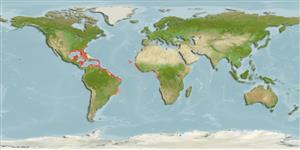>
Holocentriformes (Squirrelfishes, soldierfishes) >
Holocentridae (Squirrelfishes, soldierfishes) > Holocentrinae
Etymology: Holocentrus: Greek, holos = full + Greek, kentron = sting (Ref. 45335).
Environment: milieu / climate zone / depth range / distribution range
Ecologia
marino associati a barriera corallina; distribuzione batimetrica 0 - 180 m (Ref. 26938), usually 8 - 30 m (Ref. 3156). Subtropical; 37°N - 25°S, 97°W - 13°E
Western Atlantic: North Carolina, USA and Bermuda to Brazil, including the Gulf of Mexico and throughout the West Indies and Caribbean shores (Ref. 3724). Eastern Atlantic: Sao Tome Island and Gabon to Angola (Ref. 51178) and St. Paul's Rocks, St. Helena and Ascension Island (Ref. 6537).
Length at first maturity / Size / Peso / Age
Maturity: Lm 14.6 range ? - 16.64 cm
Max length : 61.0 cm TL maschio/sesso non determinato; (Ref. 3634); common length : 25.0 cm TL maschio/sesso non determinato; (Ref. 5217)
Spine dorsali (totale): 11; Raggi dorsali molli (totale): 15-16; Spine anali 4; Raggi anali molli: 9 - 10. Tip of membranes of spinous dorsal fin reddish or translucent, not whitish; posterior margin of upper jaw reaching posterior margin of pupil (Ref. 13608). Spiny and soft parts of dorsal fin nearly separate, but connected by low membrane (Ref. 26938). Dull red or pinkish, sometimes blotched (Ref. 7251).
Occurs in shallow coral reefs, as well as deeper offshore waters (Ref. 3724). A nocturnal species, hiding in deep crevices or under coral ledges during the day; at night it usually moves over sand and grass beds, taking mainly crabs and other small crustaceans (Ref. 3634). Capable of producing sounds (Ref. 6537). Spawning documented as far north as North Carolina in May (Ref. 27549). Marketed fresh (Ref. 3724).
Life cycle and mating behavior
Maturità | Riproduzione | Deposizione | Uova | Fecundity | Larve
Robins, C.R. and G.C. Ray, 1986. A field guide to Atlantic coast fishes of North America. Houghton Mifflin Company, Boston, U.S.A. 354 p. (Ref. 7251)
IUCN Red List Status (Ref. 130435)
Threat to humans
Reports of ciguatera poisoning (Ref. 30303)
Human uses
Pesca: scarso interesse commerciale; Acquario: Acquari pubblici
Informazioni ulteriori
BibliografiaAcquacolturaProfilo di acquacolturaVarietàGeneticaElectrophoresesEreditarietàMalattieElaborazioneNutrientsMass conversion
Strumenti
Special reports
Download XML
Fonti Internet
Estimates based on models
Preferred temperature (Ref.
123201): 23.4 - 28, mean 26.1 °C (based on 472 cells).
Phylogenetic diversity index (Ref.
82804): PD
50 = 0.7500 [Uniqueness, from 0.5 = low to 2.0 = high].
Bayesian length-weight: a=0.01622 (0.01297 - 0.02028), b=2.97 (2.91 - 3.03), in cm total length, based on LWR estimates for this species (Ref.
93245).
Trophic level (Ref.
69278): 3.1 ±0.3 se; based on diet studies.
Resilienza (Ref.
120179): Medio, tempo minimo di raddoppiamento della popolazione 1.4 - 4.4 anni (Preliminary K or Fecundity.).
Fishing Vulnerability (Ref.
59153): Moderate vulnerability (44 of 100).
Nutrients (Ref.
124155): Calcium = 21.1 [9.3, 54.2] mg/100g; Iron = 0.544 [0.219, 1.093] mg/100g; Protein = 19.2 [18.0, 20.3] %; Omega3 = 0.231 [0.095, 0.539] g/100g; Selenium = 23.2 [12.7, 44.7] μg/100g; VitaminA = 30.6 [10.8, 90.6] μg/100g; Zinc = 0.719 [0.446, 1.132] mg/100g (wet weight);
